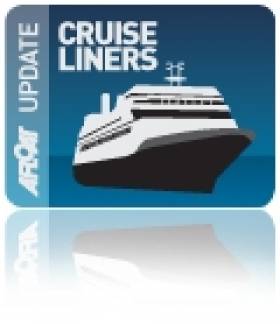Displaying items by tag: Dublin Not Dun Laoghaire
#SplendidaSwitchPorts - MSC Cruises operators of the massive MSC Splendida have confirmed that the ship will be back for a second visit to Dublin Port at 4.30am this Thursday, May 21.
Following MSC Splendida's debut call last week (Monday, May 11) as previously reported on Afloat.ie, the cruiseship had been scheduled to anchor offshore at Dun Laoghaire, but has now changed its plans to re-enter Dublin Port.
"Getting MSC Splendida into Dublin Port is no mean feat," said Giles Hawke, MSC Cruises executive director for the UK and Ireland.
"But judging by the amazing feedback we have received, it is certainly an effort worth making. Our cruise guests love the convenience of being able to disembark quickly and make the most of their time in such a beautiful and friendly city."
MSC Splendida made maritime history as the largest cruise ship ever to dock in Dublin Port during her recent visit, and staff were "blown away" by the amount of people lining the Liffey to wave it off, Hawke added.
Having carried out preparations for the anticipated visit, however, the Dun Laoghaire Harbour Company expressed dismay over the change of plans.
"We are disappointed and surprised that the MSC Splendida has transferred its call to Dublin Port, considering that this was a scheduled anchorage call to Dun Laoghaire Harbour," said Captain Simon Coates, Habour Master, Dun Laoghaire Harbour.
Dun Laoghaire had expected to welcome 21 cruise ships this season; while Dublin Port is set to welcome 83.
For much more The Independent has a report here.
Afloat.ie adds that Royal Princess (see previous report) which is even larger than the MSC Splendida was due to make a return call to Dun Laoghaire this Sunday, however according to the Dublin Port cruise schedule she is also instead to call to the capital on Sunday.
The Royal Princess had been due to make a repeat anchorage call off Dun Laoghaire Harbour that same day next weekend though this will be her first call to Dublin Port.
Royal Princess at 142,000 tonnes is in fact larger than MSC Splendida and will so outpace last week's record for the largest ever ship of any type to visit Dublin Port. As for length, MSC Spendida still holds that title as the longest cruiseship ever at 333m to enter the port.
Afloat.ie will have more to add to this latest developmment.
In the meantime, Dun Laoghaire Harbour Company can look forward tomorrow (May 20) to the visit of Cunard Line's flagship Queen Mary 2, the cruise-liner having made her debut off the south Dublin Bay port in 2013.





























































